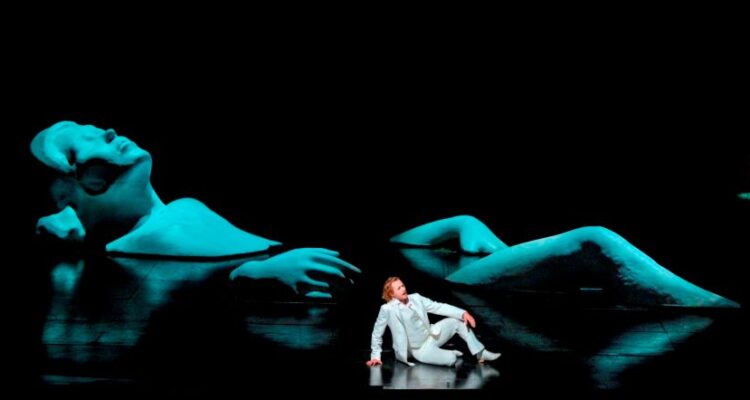The ancient myth of Orpheus and his tragic love for Eurydice has sprung numerous adaptations in film, literature and music. The latest retelling is in a form of a hit musical – Hadestown by Anaïs Mitchell. As Orpheus is a legendary musician and poet who tests the boundaries of his art, one can easily see the attraction of this story to artists who explore the metaphoric subtext of the story.
The earliest opera to tell the story of Orpheus’ descent to the underworld way back in 1607, was Claudio Monteverdi’s gorgeous L’Orfeo – one of the earliest operas ever written. Christoph Willibald Gluck’s version, written 155 years later, is the most performed today. Last seen at the Israeli Opera in 2012 it now returns with a new production directed and designed by the Israeli actor, director and choreographer, Yehezkel Lazarov, who has recently performed Tevye in Fiddler on the Roof during a three-year Broadway tour in the USA. This is his first opera.
When the audience enters the theatre, Orpheus is already sitting by a grand piano on a bare stage, playing some notes. When Italian conductor Matteo Beltrami enters, the piano is pushed back, and Amor comes in, dressed as a conductor, and holding a baton, mirroring the orchestra conductor. The first dramatic scene includes a screening of a forest road as seen by the driver of a car racing in the night, foreshadowing a fatal accident. In front of the screen the chorus, all dressed in black evening suits, pass among themselves Eurydice’s wedding cloths, and bits of a car. Orpheus and Euridice move among the chorus members and finally put all the bits together to mime the just married couple driving a car.
It is a beautiful and suggestive opening that will be echoed in the final scene. The next scene is the most striking of the evening. Parts of a huge white statue of Euridice are laid on the black stage creating an image of a drowned woman (echoing another tragic heroine – Ophelia). Orpheus is walking lost among the parts, mourning the death of his beloved bride, as if constantly surrounded by the memory of her presence.
The scene in which Euridice arrives in the underworld is also quite beautifully conceived, including a group dance by couples of brides and grooms, and black sheep that serve as offering to the boatman and/or as that thing that hit the racing car in the opening scene. Later scenes, however, are problematic. As Orpheus tries to get Euridice to follow him without question and she nags that he stopped loving her, a hospital bed is brought onto the stage while medical instruments are shown of the screen behind, and this new concept doesn’t seem to fit with the earlier visual metaphors. It is then that the simple story falls apart.
The last scene returns to the first, rewinding both the film and movement of the singers and dancers, as if trying to cancel the death of Euridice. But in the end Orpheus is all alone by his piano. This is an interesting idea, not yet perfectly timed.
Musically the performance on opening night was only partly satisfying. American counter tenor Nicholas Tamagna in the role of Orpheus has a clear and dulcet voice, and he sang beautifully throughout. Euridice was sung by the usually superb Israeli soprano Alla Vasilevitsky (she was wonderful as Rusalka in the Israeli Opera’s previous production). However, Euridice is a less impressive, and not very well-defined role, and she didn’t seem to be at her best. The weakest link was Israeli Soprano Tal Ganor in the role of Amor. At times her voice was hardly heard.
The Israeli Opera Chorus have also sounded better in the past. The problem, so it seems, has to do with the acoustics of the stage. When the singers stood at the front of the stage, they sounded harmonious and beautiful. However, quite often they were sent to the back of the stage, and they sounded muffled. If there is a problem with the stage, a director should probably take that into consideration and think not only about the visual aspect. The orchestra also didn’t always sound a sharp as one might hope. All in all it is an interesting but not completely successful production, with some inspired images, and others less so.
Opera
Music by Christoph Willibald Gluck
Director and Set Designer: Yehezkel Lazarov
Conductor: Matteo Beltrami
Sung in Italian with Hebrew and English surtitles
Cast: Nicholas Tamagna, Alla Vasilevitsky, Tal Ganor
The Israeli Opera Tel-Aviv-Yafo האופרה הישראלית תל-אביב-יפו
Running time: 80 minutes without intermission
Photography: Yossi Zwecker

